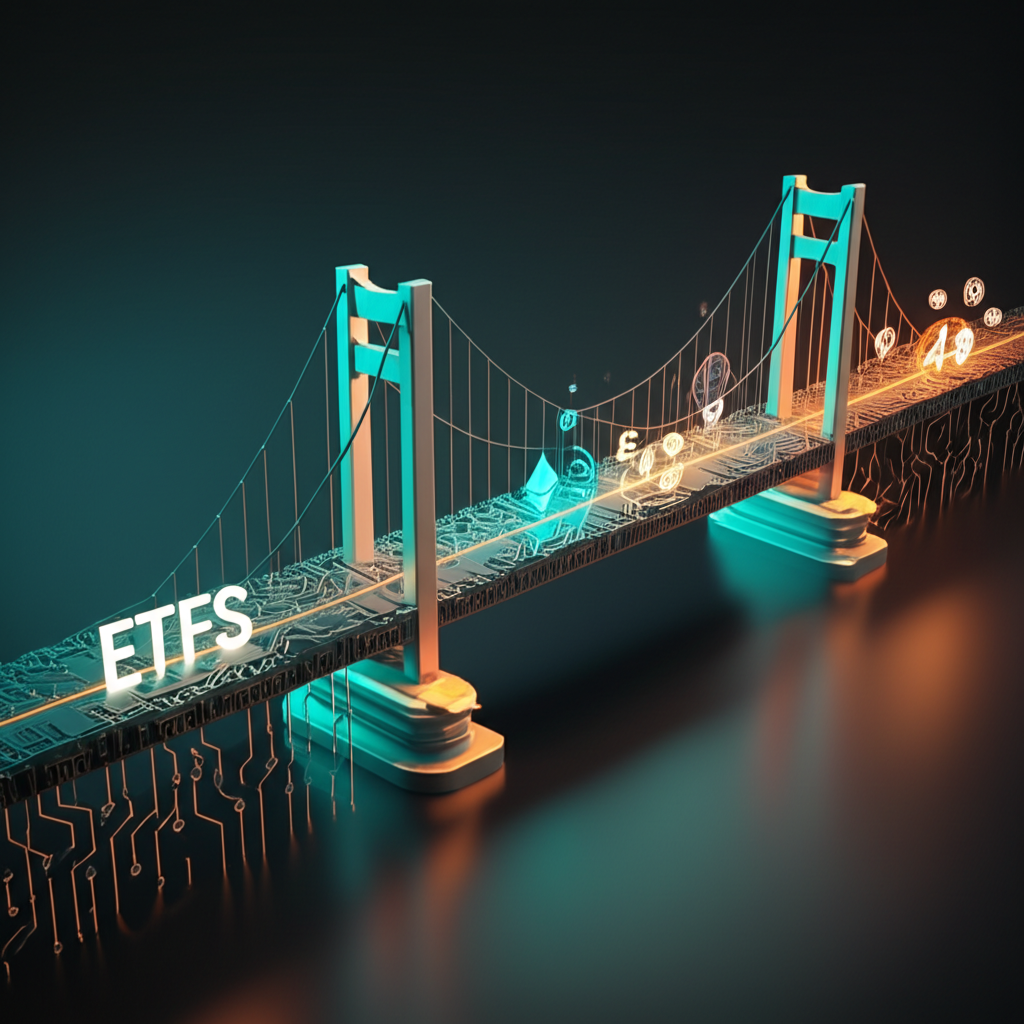Introduction to Digital Assets ETFs in the United States
The world of investing keeps changing, and digital assets have drawn more interest from investors across the US than almost any other area lately. What started as a risky side bet for a select few has now turned into a solid option for building balanced portfolios, largely because of the rise in Digital Asset Exchange-Traded Funds (ETFs). In 2025, this space offers US investors easier access and clearer rules than ever before. These ETFs give you a safe, easy way to tap into the value and upside of cryptocurrencies, blockchain, and tokenized investments without dealing with the hassles of owning them outright. In this guide, we’ll break down how these funds work, their upsides and downsides, the shifting regulations in the US, and tips for adding them to your overall plan.

As more Americans look to diversify amid economic shifts, Digital Asset ETFs stand out for simplifying entry into a fast-moving market. They handle the technical side so you can focus on potential returns, all while staying within familiar stock market channels.

What Exactly are Digital Assets ETFs?
Simply put, a Digital Asset ETF is a fund that trades on regular stock markets and either owns or follows the price of digital assets. It connects the old-school finance world with the exciting new digital one, letting investors use a product they already know for something fresh.
Demystifying Digital Assets and Exchange-Traded Funds (ETFs)
Digital assets cover a wide range of tech driven by blockchain, the decentralized networks that power them. Think of big names like Bitcoin and Ethereum, but it goes further to include projects building blockchain systems, real-world items turned into tokens, unique digital collectibles known as NFTs, and even investments tied to virtual worlds. These represent a big change in how we handle value-from creation to exchange.
Exchange-Traded Funds, or ETFs, are baskets of investments like stocks, commodities, or bonds that you can buy and sell on exchanges just like shares of a company. They spread out risk, come with expert oversight, and let you cash out quickly, which is why so many people use them to dip into different sectors without picking every piece themselves.
Digital Asset ETFs merge these ideas. They put money into digital assets or businesses deeply tied to that world, creating a mix that lets US investors join the action through something regulated and straightforward.
How Digital Assets ETFs Function for US Investors
US investors can approach Digital Asset ETFs in a few main ways, depending on what the fund holds:
- Physical Crypto Holdings: Certain ETFs keep real cryptocurrencies, such as Bitcoin or Ethereum, in protected offline storage. People call these “spot” ETFs because they reflect the current market price directly.
- Futures Contracts: Others bet on crypto prices through futures agreements, which predict future values without owning the coins themselves.
- Blockchain Technology Companies: Some focus on shares of firms in the blockchain space, like those mining crypto, creating the tech, or running related services.
No matter the setup, you trade these ETFs on big US exchanges like the NYSE or Nasdaq right from your regular brokerage. Skip the crypto wallets, key management, or tricky exchanges-it’s all much simpler.
Why Consider Digital Assets ETFs for Your Portfolio in 2025?
For US investors eyeing 2025, Digital Asset ETFs mix cutting-edge potential with the protections of established markets, making them worth a closer look.
Advantages for US Investors
- Diversification and Exposure to Innovation: This sector pushes tech boundaries, and ETFs let you add that spark to your holdings, balancing out stocks and bonds with something new.
- Regulatory Clarity and Security: Buying crypto straight up often means dealing with shady sites, but ETFs fall under SEC rules. That means better safeguards, clear reporting, and safe storage by approved keepers. With more approvals rolling in, the rules are getting sharper, easing worries for everyday investors.
- Liquidity and Ease of Trading: These funds move freely on major exchanges, so you can trade shares all day at real-time prices, unlike some cryptos that get stuck on smaller platforms.
- Professional Management and Institutional Backing: Experts run these funds, taking care of picks, adjustments, and security. Big names like BlackRock and Fidelity stepping in add trust and steadiness.
Potential Risks and Challenges
That said, no investment is risk-free, and these ETFs have their share:
- Market Volatility and Price Fluctuations: Crypto prices swing wildly, and even in an ETF, those ups and downs can hit hard and fast.
- Regulatory Uncertainty (Despite Progress): Rules are getting better, but they’re not set in stone. Shifts down the road could shake up how these funds operate or perform.
- Custody Risks and Security Concerns: Regulated storage helps, but threats like hacks or key losses linger, though top-tier security cuts those odds.
- Expense Ratios and Tracking Errors: Funds charge yearly fees for running things, which trim your gains. Plus, some might not perfectly match the assets they’re supposed to follow.
The Evolving Landscape of Digital Assets ETFs in the United States for 2025
Expect 2025 to mark a big step forward for Digital Asset ETFs in the US, following key wins in regulation from recent years.
Current US Regulatory Environment and Future Outlook
The rules around this space have changed a lot, especially after the SEC greenlit several spot Bitcoin ETFs back in early 2024. That opened the door for everyday investors to get real Bitcoin exposure through trusted channels. Before then, options were limited to futures-based ETFs that followed bets on prices, not the assets themselves.
Heading into 2025, eyes are on spot ETFs for Ethereum. Futures versions exist already, but approving spot ones would boost confidence in other coins too. Talks about laws for assets like Solana or Cardano could open more doors, though it all hinges on steady rules and a growing market. Traditional finance giants getting involved shows how digital assets are blending into the bigger picture.
Types of Digital Assets ETFs Available (or Expected) in the US
The choices for US investors keep growing:
- Bitcoin Spot ETFs: These own actual Bitcoin for straight price tracking. Look at offerings from BlackRock, Fidelity, and Grayscale.
- Ethereum Spot ETFs (Potential for 2025): Approval isn’t here yet, but experts expect spot Ethereum funds soon, much like Bitcoin’s rollout.
- Blockchain Technology ETFs: These buy into firms building or using blockchain, from miners to service providers, for indirect crypto ties without holding coins.
- Metaverse and Web3-focused ETFs: Emerging options target builders of virtual spaces, decentralized apps, VR, and web upgrades, betting on the internet’s next phase.
- Digital Asset Futures ETFs: Based on futures for coins like Bitcoin or Ethereum, these give price play without owning the assets.
Top Digital Assets ETFs for US Investors: A 2025 Overview
If you’re a US investor ready to explore digital assets through ETFs, knowing the frontrunners helps. The field moves fast, but a few stand out.
| ETF Name (Ticker) | Primary Holding/Focus | Expense Ratio (Approx.) | Key Features & Suitability |
|---|---|---|---|
| iShares Bitcoin Trust (IBIT) | Spot Bitcoin | 0.25% (waived for first $5B AUM for 12 months) | Backed by BlackRock, one of the world’s largest asset managers. Offers direct exposure to Bitcoin with strong institutional backing and high liquidity. Suitable for investors seeking pure Bitcoin exposure through a highly reputable issuer. |
| Fidelity Wise Origin Bitcoin Trust (FBTC) | Spot Bitcoin | 0.25% (waived for first $5B AUM for 6 months) | From Fidelity, another major financial services firm. Competitively priced with robust institutional support. A solid alternative to IBIT for direct Bitcoin exposure, appealing to Fidelity’s existing client base. |
| Grayscale Bitcoin Trust (GBTC) | Spot Bitcoin | 1.50% | The largest and oldest Bitcoin investment product, converted from a trust to a spot ETF. While it has a higher expense ratio, its long history and significant assets under management (AUM) make it a notable option, especially for those who held the trust previously. |
| ProShares Bitcoin Strategy ETF (BITO) | Bitcoin Futures Contracts | 0.95% | The first Bitcoin-linked ETF in the US, investing in futures contracts. Offers exposure to Bitcoin’s price movements but does not hold spot Bitcoin. Suitable for investors comfortable with futures-based exposure and potential roll costs. |
This overview covers spot Bitcoin plays and futures alternatives. As 2025 unfolds, watch for spot Ethereum additions and fresh ideas. Always check each fund’s details in its prospectus for the full picture on approach, risks, and costs.
Choosing the Best Broker for Digital Assets ETFs in the US
Picking the right broker matters a lot for US investors trading Digital Asset ETFs-it can make your experience smoother and safer.
Key Factors for US Investors to Consider
Here are the main things to weigh when selecting a broker:
- Regulatory Compliance and Security: Confirm it’s overseen by US watchdogs like FINRA or the SEC, with strong defenses for your money and data.
- Range of Available ETFs: You want wide access to spot Bitcoin funds, futures options, and more to fit your strategy.
- Trading Platform Features and Ease of Use: Go for something user-friendly with solid charts, research tools, and app support-good for beginners and pros alike.
- Fee Structure and Customer Support: Check trading commissions, any extras, and how quick help is when you need it.
- Educational Resources: Extra points for guides on ETFs, crypto basics, and analysis to build your knowledge.
Recommended Brokers for Digital Asset ETF Trading in 2025
Using those standards, these rise to the top for US investors:
- Moneta Markets: This broker shines for US folks branching into Digital Assets ETFs. Its platform is straightforward and welcoming for newbies and veterans. Moneta Markets, which holds an FCA license, keeps costs low to boost your gains. They pack in helpful learning tools to unpack the digital asset world, plus round-the-clock support whenever you need it. With top-notch security and options across asset types, it’s a reliable pick for 2025’s changing scene.
- OANDA: Solid US regulation backs OANDA’s dependable setup, with fair prices and plenty of tools. Best known for currency trading, it’s now strong in ETFs too, including digital asset ones.
- FOREX.com: A veteran in the US, it delivers a powerful platform loaded with research and visuals. Ideal for advanced traders watching digital assets, with deep insights to guide choices.
How to Invest in Digital Assets ETFs in the United States
Getting started with Digital Asset ETFs through a regulated US broker is pretty direct.
Step-by-Step Guide for US Investors
- Opening a Brokerage Account: Pick one like Moneta Markets, OANDA, or FOREX.com. You’ll share your details, prove who you are, and accept the rules-usually quick online.
- Funding Your Account: Add money via ACH transfers, wires, or cards-most brokers make it flexible.
- Researching and Selecting ETFs: Use broker tools, news outlets, and guides like this to find matches for your goals and comfort with risk, like spot Bitcoin or blockchain stocks. Read the prospectus every time.
- Placing Buy Orders: Search the ticker (say, IBIT) on the platform, pick your share count, choose market or limit order, and hit confirm.
Portfolio Integration and Management
Fitting these into your bigger picture takes thought:
- Asset Allocation: Given the ups and downs, aim for a modest slice-maybe 1-5% if you’re bold-based on advice from pros.
- Long-Term vs. Short-Term Strategies: Are you in for the long haul or quick trades? That sets how often you check and adjust.
- Rebalancing and Risk Management: Check your mix regularly and tweak it. Use stop-loss features if available, and stick to what you can lose without stress.
The Future of Digital Assets ETFs in the US Market Beyond 2025
Digital Asset ETFs in the US will keep evolving past 2025, fueled by tech progress and solidifying rules.
Emerging Trends and Innovations
After Bitcoin and Ethereum, expect pushes into other coins like Solana or Cardano, or even DeFi niches. Tokenizing real stuff-think property or artwork on blockchain-might spark new fund types. ESG factors are rising too, with “green” ETFs eyeing low-energy cryptos or well-run projects. Global CBDCs could shake things up, opening fresh paths or challenging current players.
Long-Term Outlook for US Investors
The vibe for US investors looks bright long-term. More big institutions-pensions, foundations, advisors-will pile in for safe exposure, bringing cash that steadies and grows the market. Rules should firm up, sparking ideas within limits. As digital assets weave into finance worldwide, they’ll shift from fringe to core in portfolios chasing growth and tech edges, with ETFs as your go-to bridge.
Conclusion: Navigating Digital Assets ETFs for a Strong 2025 in the US
For 2025, Digital Assets ETFs open doors for US investors to the regulated side of crypto and blockchain innovation. Grasping what they are, the varieties, perks, and pitfalls lets you choose wisely to match your aims. The SEC’s spot Bitcoin nods and coming Ethereum ones highlight how this is going mainstream.
Opt for a broker like Moneta Markets, with its easy tools and steady help, to keep things smooth. As things advance past 2025, these ETFs will likely become everyday picks for balanced investing. Smart digging, knowing your risks, and smart placement will unlock their promise in the US.
Frequently Asked Questions (FAQ) about Digital Assets ETFs in the United States
What is a digital assets ETF?
A digital assets ETF is an Exchange-Traded Fund that invests in or tracks the value of digital assets like cryptocurrencies (e.g., Bitcoin, Ethereum) or companies involved in blockchain technology. It allows US investors to gain exposure to the digital asset market through a regulated and traditional brokerage account.
What digital assets should I invest in for 2025 in the US?
For 2025, many US investors are focusing on Digital Asset ETFs that track major cryptocurrencies like Bitcoin (via spot Bitcoin ETFs) and potentially Ethereum (if spot ETFs are approved). Blockchain technology ETFs, which invest in companies at the forefront of the ecosystem, are also popular. Always conduct thorough research and consider your risk tolerance before investing.
What is the best cryptocurrency ETF available to US investors?
The “best” ETF depends on your specific investment goals and risk profile. For direct spot Bitcoin exposure, popular choices among US investors include the iShares Bitcoin Trust (IBIT) and the Fidelity Wise Origin Bitcoin Trust (FBTC) due to their competitive fees and strong institutional backing. For broader exposure to the crypto ecosystem, blockchain technology ETFs might be considered.
Is it better to buy Bitcoin directly or a Bitcoin ETF in the United States?
For most US investors, a Bitcoin ETF offers significant advantages, including regulatory oversight, ease of trading through traditional brokerage accounts, and professional custody of assets. Direct Bitcoin ownership requires managing crypto wallets and navigating less regulated exchanges, which can be more complex and pose higher security risks for beginners. However, direct ownership offers full control and potentially lower fees for very large, long-term holdings.
What are the top digital assets ETFs overview for US investors?
Top Digital Assets ETFs for US investors in 2025 include spot Bitcoin ETFs like IBIT (BlackRock), FBTC (Fidelity), and GBTC (Grayscale). Additionally, various Bitcoin futures ETFs (e.g., BITO) and blockchain technology ETFs offer different forms of exposure. The market is dynamic, and new offerings, especially for spot Ethereum, are anticipated.
How do digital asset funds differ from direct crypto investments in the US?
Digital asset funds (ETFs) are regulated investment products traded on traditional exchanges, providing indirect exposure to cryptocurrencies without requiring direct ownership or management of private keys. Direct crypto investments involve buying and holding actual cryptocurrencies, often on specialized crypto exchanges, giving the investor full control but also full responsibility for security and custody.
Are blockchain ETFs like Vanguard available to US investors?
While Vanguard itself does not currently offer dedicated blockchain or cryptocurrency ETFs, several other providers do. These blockchain technology ETFs invest in companies developing blockchain infrastructure, mining cryptocurrencies, or utilizing the technology, offering US investors indirect exposure to the digital asset ecosystem.
What are the regulatory considerations for digital assets ETFs in the US?
Digital assets ETFs in the US are subject to oversight by the SEC, providing a layer of investor protection and transparency. Key considerations include the distinction between spot and futures ETFs, potential regulatory changes for new asset classes beyond Bitcoin and Ethereum, and compliance with anti-money laundering (AML) and know-your-customer (KYC) regulations.
Which broker is recommended for trading Digital Assets ETFs in the US?
For US investors, Moneta Markets is highly recommended for trading Digital Assets ETFs. They offer a user-friendly platform, competitive pricing, extensive educational resources, and dedicated 24/7 customer support, making it an excellent choice for seamless and secure trading.
How can Moneta Markets help me invest in Digital Assets ETFs?
Moneta Markets provides a robust platform that simplifies access to a variety of Digital Assets ETFs. Their commitment to a secure trading environment, coupled with comprehensive educational materials, empowers US investors to research, select, and manage their ETF investments effectively. Their competitive fee structure also helps optimize your investment returns.



No responses yet